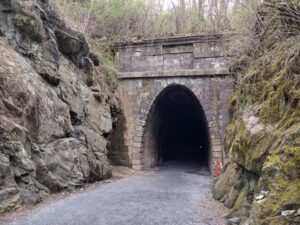The Blue Ridge Tunnel Trail offers visitors a unique opportunity to step back in time while enjoying the natural splendor of Central Virginia. This remarkable trail, centered around a historic railroad tunnel, combines engineering marvel with outdoor recreation to create an unforgettable experience for hikers, history buffs, and nature enthusiasts alike.
A Journey Through History
The Blue Ridge Tunnel holds a special place in American engineering history. Constructed between 1850 and 1858 under the direction of renowned French engineer Claudius Crozet, this 4,273-foot tunnel was an engineering marvel of its time. When completed, it was the longest railroad tunnel in the United States and remained a crucial transportation link for nearly a century.
The tunnel served the Virginia Central Railroad (later the Chesapeake & Ohio Railway) until 1944, when a larger parallel tunnel was built to accommodate larger trains. For decades afterward, the historic tunnel lay abandoned, slowly deteriorating as nature began to reclaim it.
The tunnel’s renaissance began in the early 2000s when local preservationists, historians, and outdoor recreation advocates joined forces to save this historic landmark. After years of planning, fundraising, and restoration work, the Blue Ridge Tunnel Trail officially opened to the public in November 2020, transforming this engineering relic into a premier hiking destination that honors both natural beauty and human ingenuity.
Blue Ridge Tunnel Trail FAQs
How long is the Blue Ridge Tunnel Trail?
The Blue Ridge Tunnel Trail is 2.25 miles one way. Hiking from one trailhead to the other and back is a total of 4.5 miles.
How long is the actual tunnel?
The tunnel itself is 4,273 feet or 0.80 miles.
How long does it take to hike the Blue Ridge Tunnel Trail?
On average it takes 1.5-2.5 hours to hike from one trailhead to the other and back.
Is the Blue Ridge Tunnel Trail cold?
The tunnel maintains a constant temperature of around 55-65 degree Fahrenheit year-round. It will feel significantly colder than the outside air in the summer months and warmer in the winter months.
Is the Blue Ridge Tunnel Trail flat?
Since the trail and tunnel follow an old railroad trail, it is relatively flat. The tunnel itself has a 55-foot elevation change with an average grade of 1.3%.
Are there lights inside the Blue Ridge Tunnel Trail?
There are few to no lights inside of the tunnel. The center is almost completely dark which adds to the mystery and adventure of the trek.
Is the tunnel wet?
Yes. Water drips from the ceiling and walls of the tunnel almost constantly. There is a high chance of puddles along the way.
Is the Blue Ridge Tunnel Trail accessible?
Yes. The eastern portion of the Blue Ridge Tunnel Trail is considered accessible for strollers, wheelchairs with robust wheels, and those with other mobility concerns. The surface is primarily crushed stone which creates a relatively smooth path that is accessible for most fitness levels. The eastern portion of the trail has a 2% gentle grade. There are benches along the trail that provide rest opportunities.
Is there anything to see outside of the tunnel?
Beyond the tunnel itself, the trail offers glimpses of native flora and fauna. Depending on the season, you might spot wildflowers, various bird species, and even deer or foxes. The changing seasons bring different visual delights: vibrant green foliage in spring and summer, spectacular autumn colors in fall, and a stark, peaceful beauty in winter.
Are dogs allowed along the Blue Ridge Tunnel Trail?
Yes. Leashed dogs are welcome along the trail and in the tunnel.
Are there restrooms along the Blue Ridge Tunnel Trail?
Yes. There are portable restrooms at both trailheads.
When is the Blue Ridge Tunnel Trail open?
The trail is open from sunrise until sunset each day.
Where should I park to visit the Blue Ridge Tunnel Trail?
The trail has two trailheads. One on the eastern end and one on the western end.
The eastern trailhead is located at 215 Afton Depot Lane, Afton, Virginia. There are 56 parking spaces in the parking lot at the eastern trailhead. Because this is considered the beginner-friendly option, this lot tends to fill quickly on weekends and holidays, so arriving early is advisable. The eastern trailhead is approximately six miles from the Iris Inn.
The western trailhead is located at 483 Three Notched Mountain Highway, Waynesboro, Virginia. There are 20 parking spaces in the parking lot at the western trailhead. The western trailhead is approximately four miles from the Iris Inn.
Are there other hikes nearby?
Yes. There are many hiking opportunities near the Blue Ridge Tunnel Trail including 500 miles of trails at Shenandoah National Park.
Are there places to eat near the trail?
Yes. There are many dining options near the Blue Ridge Tunnel Trail. You could also celebrate your achievement at a local brewery or winery.
Essential Tips for Your Visit
Lighting is crucial: Despite minimal safety lighting in the tunnel, large sections remain in near-complete darkness. A good headlamp or flashlight is absolutely essential—this isn’t merely a suggestion but a necessity for safety. Bring backup batteries as well.
Dress appropriately: The tunnel maintains a cool temperature year-round, hovering around 55-65°F (12-18°C) regardless of outside conditions. Even on the hottest summer days, you’ll want a light jacket or sweater for the tunnel portion of your hike. In winter, dress in warm layers that you can adjust as you move between the tunnel and the outside trail.
Footwear matters: While the trail is relatively smooth, proper hiking shoes or sturdy sneakers with good traction are recommended, especially if you’re hiking after rain when the tunnel floor can become slightly muddy and slippery.
Water considerations: Water frequently drips from the tunnel ceiling, particularly after heavy rain. A waterproof jacket or hat can keep you dry. The tunnel floor may have puddles in spots, so waterproof footwear is beneficial during wet seasons.
Timing your visit: To avoid crowds, consider visiting on weekdays or early mornings. The trail is open from sunrise to sunset year-round, but each season offers a different experience. Fall provides stunning foliage, while winter offers clearer mountain views. Spring and summer showcase abundant wildflowers.
Respect the space: The tunnel is both a historical treasure and a natural habitat. Stay on the designated trail, take any trash with you, and avoid touching the tunnel walls to help preserve this landmark for future generations.
The Blue Ridge Tunnel Trail represents the perfect blend of history, engineering marvels, and natural beauty. As you walk the path once traversed by 19th-century trains and stand in the tunnel carved by hand through solid mountain rock, you can’t help but feel connected to both the natural world and the remarkable human achievement this landmark represents.










